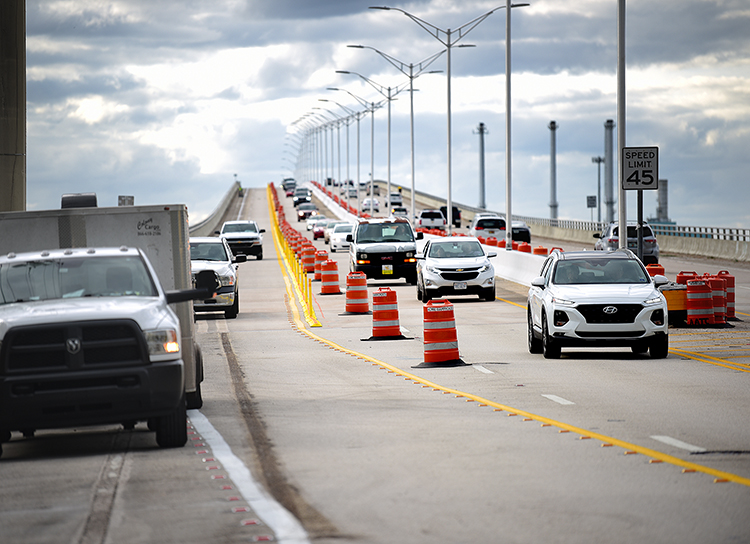
Last week, amid the community’s growing frustration with the traffic congestion caused by the seemingly endless repairs to the 17th Street Bridge, state transportation officials provided me with a lagoon-level tour of the $2.3-million project and an explanation for why it’s taking so long.
I saw the work up close from a jon boat floating below the eastern end of the 42-year-old structure and nobody dodged my questions, which were many.
I’m not an engineer, but based on what I saw, everything the Florida Department of Transportation folks and their contractor said seemed to make sense.
So, here’s my takeaway:
- The bridge is safe for motorists to cross. If there were any risk of structural failure, FDOT would post weight limits or, in severe situations, close the roadway.
- The damage to the bridge’s support beams was caused by chloride intrusion from the salty water that flows in the lagoon below. Engineers say chloride intrusion is responsible for nearly 40 percent of the failures of concrete structures.
- The project is taking longer than expected because the engineering required to make the repairs was more involved than anticipated; and once the work began, the process was more tedious and has moved slower than anyone thought it would.
“These kinds of projects aren’t uncommon – especially in a highly corrosive, saltwater environment – but the specialty engineering that designed the system needed to accommodate the repairs for this particular bridge was unique,” FDOT District 4 Transportation Operations Director Paul Lampley said.
“Then,” he continued, “because the east end of the bridge is so close to the water level, we’ve got to work around the tides to set up the jacks and install the brackets needed to make the actual repairs.
“There’s not much headroom under that section of the bridge, anyway, and there’s almost no room at high tide, so we can use only one six-man crew at a time, and we have a narrow window of time.”
“Combine all those factors, and it becomes a very time-consuming process.”
According to Lampley, FDOT’s contractors are using four jacks, each capable of lifting 65 tons, to raise the bridge’s support beams – 1 inch, one section at a time – to provide the opening needed for work crews to chip away the damaged sections and install the new concrete.
The crews, which work from a portable 12-by-8-foot platform and often in tight quarters, then must wait five days for the concrete to cure before testing it.
“We can’t do this at night, but we’re working 10 hours a day during the daytime and on weekends,” Lampley explained, adding that the damage to the bridge was not worse than expected.
“People driving past don’t see it, because we’re under the bridge, but the work is getting done,” he said. “We’ve finished eight of the 10 beams. It’s just taking longer than we planned.”
Since November, both eastbound and westbound traffic on and off the barrier island has been routed to two lanes on the south side of the bridge while the north side is being repaired – a multi-phase project Lampley said was supposed to take six months to complete.
The first two phases involved the installation of new barrier walls in the middle of the bridge, railing and LED lighting, all visible to motorists. The third phase involved repairs to the damage on the underside of the bridge.
However, because of the engineering delays, the first beam wasn’t lifted until February. Now, work on the westbound side isn’t expected to be finished until next month, which will be nine months after the scheduled start date.
FDOT’s contractor will then move to the south side of the bridge, where Lampley predicts the work will be completed no later than January. The south side of the roadway will remain closed to pedestrians and bicyclists until then.
“All the engineering work is already done,” he said. “We hope to be done by the end of the year, but, depending on weather, it might carry over into January.
”For those wondering: FDOT officials say the delays haven’t increased the project’s costs.
As for the summer rains, Lampley said they don’t hinder the concrete curing process. Summer storms, however, can bring strong winds and rough waters, which can prevent crews from working under the bridge.
And, of course, a hurricane could interrupt the project for weeks.
When the project is done, Lampley said the bridge will no longer be “structurally deficient” – its rating after a May 2020 inspection that prompted the emergency repairs.
“We’re actually inspecting each section as we go, but once all the repairs have been completed, we’ll do a final inspection and assess the condition of the entire bridge,” Lampley said. “The rating will improve considerably. It won’t be structurally deficient.”
Still, local motorists can expect deja vu all over again in 2024, when FDOT plans to fully replace nine spans on the eastern half of the bridge, which opened in 1979 and was renamed in honor of longtime Indian River County civic leader Alma Lee Loy.
There’s currently no need to replace spans on the western half of the bridge because its underside is higher above the water and, therefore, not as susceptible to damage from salt water and salt air.
“The west end is fine,” Lampley said.
The 2024 project, which FDOT officials say is budgeted for $11.6 million, also will require traffic in both directions to be routed to either the eastbound or westbound side of the bridge while construction is done on the other side.
“We’ll do it in two phases and the entire project should take 18 months,” Lampley said. “We expect to get the contract in August 2023 and start in January 2024, with completion scheduled for the summer of 2025.”



